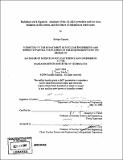| dc.contributor.advisor | Jacquelyn C. Yanch. | en_US |
| dc.contributor.author | Esparza, Enrique | en_US |
| dc.contributor.other | Massachusetts Institute of Technology. Dept. of Nuclear Science and Engineering. | en_US |
| dc.date.accessioned | 2008-05-19T15:57:41Z | |
| dc.date.available | 2008-05-19T15:57:41Z | |
| dc.date.copyright | 2006 | en_US |
| dc.date.issued | 2006 | en_US |
| dc.identifier.uri | http://hdl.handle.net/1721.1/41588 | |
| dc.description | Thesis (S.B.)--Massachusetts Institute of Technology, Dept. of Nuclear Science and Engineering, 2006. | en_US |
| dc.description | Includes bibliographical references (leaves 36-39). | en_US |
| dc.description.abstract | Currently there are a growing number of radiation workers. In order to ensure the safety of the employees, regulations have been established by the federal government and state governments to limit the dose equivalent to radiation workers. The most well known strategy for reducing radiation doses in the work place is the ALARA principle which stands for "as low as reasonably achievable". Within the phrase, "reasonably achievable" there is an implied element of subjectivity. Because "reasonably achievable" can vary in meaning for different people, this paper will analyze the ALARA principle in detail. Also, the manner in which inconclusive data on low dose radiation are treated in the court rooms will be evaluated. A secondary part of the paper will deal with what happens when accidents occur to radiation workers. Specifically, this paper will deal with the accidents at Kerr-McGee, Three Mile Island and SONGS. The thesis will delve into the litigation that followed the radiation accidents and analyses of the rulings, and will look at where current radiation litigation is heading. | en_US |
| dc.description.statementofresponsibility | by Enrique Esparza. | en_US |
| dc.format.extent | 39 leaves | en_US |
| dc.language.iso | eng | en_US |
| dc.publisher | Massachusetts Institute of Technology | en_US |
| dc.rights | M.I.T. theses are protected by
copyright. They may be viewed from this source for any purpose, but
reproduction or distribution in any format is prohibited without written
permission. See provided URL for inquiries about permission. | en_US |
| dc.rights.uri | http://dspace.mit.edu/handle/1721.1/7582 | en_US |
| dc.subject | Nuclear Science and Engineering. | en_US |
| dc.title | Radiation and litigation : analyses of the ALARA principle and low dose radiation in the courts, and the future of radiation in court cases | en_US |
| dc.title.alternative | Analyses of the ALARA principle and low dose radiation in the courts, and the future of radiation in court cases | en_US |
| dc.type | Thesis | en_US |
| dc.description.degree | S.B. | en_US |
| dc.contributor.department | Massachusetts Institute of Technology. Department of Nuclear Science and Engineering | |
| dc.identifier.oclc | 213482682 | en_US |
